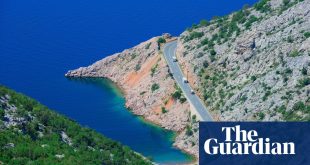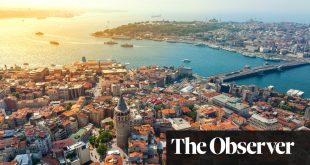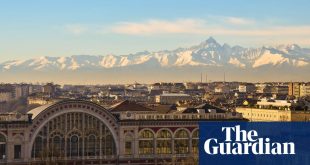With the tide out, it is a magical moment, rivulets of water swirl and eddy through the sand, the white cliffs of Cap Blanc-Nez loom behind me. There’s not a soul in sight. This jagged headland marks the start of the Côte d’Opale, which runs south-west from Calais for about 75 miles, and is part of the Pas-de-Calais region.
While most travellers arriving in Calais or Boulogne head straight for Paris and beyond, I’m here to explore this affordable and often bypassed corner of France. The wild “Opal Coast” has sandy beaches, fishing ports and quaint seaside resorts, and 30 miles inland are the fascinating and attractive vegetable gardens of the Audomarois: immense, unspoilt wetlands outside the medieval town of Saint-Omer, my next destination.
The Cap Blanc-Nez juts out from sheer chalk cliffs that run to a second wild promontory, Cap Gris-Nez. Hiking or biking the 10 miles separating the two capes can take a day: the route runs across deserted dunes and beaches that feel endless. Just by Cap Blanc-Nez, the friendly, family-run Hôtel l’Escale is a good base for exploring the coast and sampling top-notch local cuisine. Third-generation chef Vincent Brignoli creates a €26 dinner menu using local, seasonal products: it might include pork terrine with endives and juniper, an intense homemade soup of chunky cod in creamy shrimp sauce, pungent maroilles cheese from a nearby artisan dairy and to-die-for chocolate mousse.
The next day I go south towards Boulogne-sur-Mer. Each resort I pass has surprises in store. Wissant has a street market every Wednesday, ideal for buying a beach picnic with village produce like La Fromagerie en Herbe’s organic goat cheese and freshly picked fruit and vegetables from Les Jardins Intrépides. The sleepy fishing village of Audresselles is famous for its flobards – flat-bottomed boats used for crab fishing (a crab festival takes place each summer) – and on the waterfront is the coast’s strangest place to stay, Le Ch’Ti Blockhaus. It’s a concrete second world war bunker converted into a four-bedroom B&B.
One mile down the road is Ambleteuse, where the beach promenade is marked by an impregnable-looking fort jutting into the sea. The Unesco-listed fortification was built in the 17th century by renowned military architect the Marquis de Vauban to protect the port. To work up an appetite, I follow the steady stream of hikers across the beach, past families foraging for shellfish among the rocks, and into sand dunes that go up to the edge of the Slack river estuary.
Arriving in Wimereux just before lunch, I have time to wander past this belle époque resort’s holiday home mansions, designed in an ornate art-nouveau wedding-cake style. It takes a good two hours to feast on the seafood platter of oysters, clams, prawns, langoustines, whelks and crab served on the seaside terrace of the Cap Nord brasserie (platter for two €49.90pp; three-course set menu €24.90), by which time the rising tide has erased the beach and huge waves crash across the boardwalk, splashing passersby.
An hour’s drive inland is Saint-Omer, a trading centre for textiles in the middle ages, today a bustling town with a Gothic cathedral, ruined medieval abbey and wonderful flower gardens along the city ramparts. Day trippers head for La Maison du Marais, an eco-centre dedicated to the flora and fauna of the Unesco-listed Audomarois marshes. From the eco-centre, a one-hour boat trip (adult €11) gives a good educational introduction, though it takes longer to get a full impression of these immense wetlands.
Covering more than 3,700 hectares (9,000 acres), the fertile marshland was transformed into agricultural land, initially by religious communities, 1,000 years ago, creating a network of canals that crisscross the Audomarois. About 170km of canals are still navigable today, and although the original island communities are now linked by bridges, and tales of post being delivered by boat are more folklore, there are still many active farming communities cultivating the floating gardens, growing carrots, leeks, artichokes, endives, lettuce and above all, some 2 million cauliflowers a year. To get a more hands-on explanation, I head to the edge of town, to take a slow boat ride through the canals with Rémy Colin, from his artisan boatyard, Les Faiseurs de Bateaux (tours lasting 1hr 45mins cost €12pp).
after newsletter promotion
Rémy actually lives out on the wetlands and comes from a family who farmed vegetable here for centuries. “I grew up on the traditional flat-bottomed bacôve boats that navigate the waterways of our marshes, and my dream was to preserve this boatbuilding patrimony,” he says. “But we never had enough boat orders to survive financially. So 10 years ago we changed direction and decided to use tourism to preserve our heritage, passing on our knowledge of the wetlands while still building boats.”
This friendly green cooperative now includes a team guiding tourists and running an outdoor restaurant and bar, Les Piquinettes, while part of their land is cultivated by an organic farmer.
Out on the water, Rémy enchants everyone with old tales and personal anecdotes of island life as the boat slowly weaves through a verdant labyrinth of narrow waterways bordered by cultivated gardens. He points out the waterside redbrick cottage his parents still live in, identifies different species of ducks and marsh birds quietly paddling past the boat and as we dip under an ancient lock gate, he recounts how farmers would even put livestock in their boats to carry them from one pasture to another.
We pass wildflowers and rushes growing on the banks, and then farmers working away in neat, earthy fields. I spot many stalls at Saint-Omer’s teeming Saturday morning market loaded with produce direct from the Audomarois. At restaurant L’Histoire de…, artisan chef Laurent Bogé proudly prepares his daily changing menu du marché with produce from local growers and farmers (three-course set menu from €21). I enjoy haddock creme brulee, beef cheeks braised in red wine, then apple and nut flan with cider ice-cream. The menu is a genuine example of farm-to-table dining – and another reminder of how this part of France offers genuine, sustainable surprises.
The trip was provided by the Pas-de-Calais Tourism Office. Double s at Hôtel l’Escale cost from €110 B&B, doubles at Ibis Saint-Omer Centre from €100 B&B. 2 Caps à Velo offers bike hire and guided tours along this coast (one-day guided tour on electric bike €80pp)
 Top Naija News: Nigerian News, Breaking News Nigeria and World News Top Naija News is a daily news publication in Nigeria, delivering the latest breaking news in Nigeria and around the world.
Top Naija News: Nigerian News, Breaking News Nigeria and World News Top Naija News is a daily news publication in Nigeria, delivering the latest breaking news in Nigeria and around the world.



